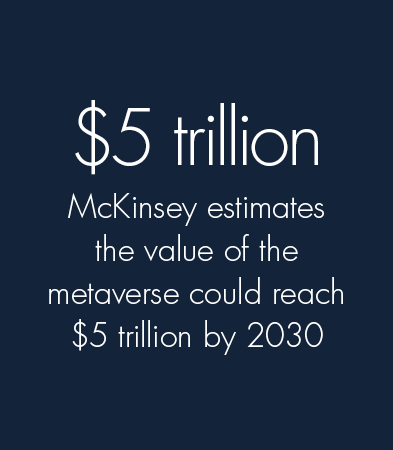A New Diamond World:
Values and Web3 Will Shape How Gen Z Buys Diamond Jewelry
Ethical assurances, branded offerings, ‘phygital’ retail and Web3 experiences will define the new diamond world.

Ethical assurances, ‘phygital’ retail strategies, branded offerings and Web3 experiences are key trends shaping how diamond consumers – in particular Gen Z – perceive and engage with diamond jewelry, according to new research published today by De Beers Group in the 2022 Diamond Insight Report, titled A new diamond world: bringing trusted brands to new generations in a digital age.
Based on previously unpublished research findings, including a new survey of 18,000 US women conducted earlier this year, the report explores how these megatrends are converging and accelerating – spurred by global events, the power of digital technology and attitudes of younger generations – to create a new future for diamond jewelry acquisition. The four trends analyzed are:
Values will underpin industry value
The report found that 36% of women overall and 39% of Gen Z now specifically seek information on a brand’s ethical credentials when buying diamond jewelry. What is more, 40% of women overall said that knowing about the positive impact of diamonds on local mining communities would make them more likely to buy diamonds, while this proportion went up to 50% for Gen Z consumers, highlighting a significant opportunity for brands and retailers to capture value differentiation by clearly communicating their values and connecting end-clients to a diamond’s provenance and story.

The rise of brands
Branded diamond jewelry represented two-thirds of all diamond jewelry purchases in the US in 2021 – double the proportion in 2015 – and almost 80 per cent of all sales by value. Branded offerings appealed most to Gen Z consumers, who saw brands as contributing to their sense of self-worth and desire for self- expression. A total of 76% of diamond jewelry purchases by Gen Z consumers were branded, compared with 64% for Gen X and only 38% for Baby Boomers. In addition, affluent consumers and those purchasing diamond jewelry for themselves were more likely to desire brands. Brands represented 74% of diamond jewelry purchases among women earning more than $150,000 (compared with 65% across all incomes), while 73% of self-purchased diamonds were branded compared with 62% for bridal and 61% for gifting.
Phygital retail is here to stay
Online sales of diamond jewelry represented 25% of US sales by value and 31% by volume in 2021. When compared with 2015, when online represented only 14% and 18% of sales respectively, the acceleration of ecommerce in recent years has been remarkable. Online purchases were higher than average among Gen Z consumers (at 42% of total Gen Z purchases), those self-purchasing (40% of total purchases) and single women (37% of total purchases). In addition, 54% of online purchases in 2021 were by people buying diamond jewelry for the first time. While this was likely due to pandemic-related store closures, it also indicates a growing trust in diamond jewelry ecommerce. Importantly, 68% of US consumers who had purchased diamond jewelry online said they intended to do so again in the future.
While diamond jewelry purchases made in-store still outweigh those made online, the full journey of buying diamond jewelry increasingly includes a digital component. It is this melding of the physical and digital retail experiences – ‘phygital’ – that today’s consumers most desire. In the US, around half (49%) of all diamond jewelry purchases are now researched online, compared with only 29% in 2015. Of that 49%, 19% of ultimate purchases occurred online while 30% were in-store, highlighting the importance of a seamless phygital offering.
Web3 and the metaverse are potential game-changers
While a compelling phygital strategy is a must for any retailer today, the arrival of Web3, NFTs and the metaverse has the potential to open up new revenue, customer acquisition and brand opportunities for diamond jewelry brands. These nascent technologies aim to merge the physical and digital worlds in previously unforeseen ways, bringing new virtual shopping, entertainment and socializing experiences to digitally-savvy consumers. With a number of high-profile luxury brands already investing heavily in this space, it promises to be an emerging area of focus for diamond brands.

Esther Oberbeck, SVP Strategy Analytics & Insights, De Beers Group, said: “This year’s Diamond Insight Report explores four key trends that are already making their mark on the diamond industry, having been accelerated by the Covid-19 pandemic, new technologies and evolving consumer expectations as Gen Z comes of age. The convergence of these trends means the diamond industry must prepare for a future where new, digital-native and socially-conscious consumers expect to engage with brands and retailers in fundamentally different ways to the generations that have come before them.”
Bruce Cleaver, CEO, De Beers Group, said: “The 2022 Diamond Insight Report demonstrates that the consumer trends we have been observing for some time – such as a desire to purchase more sustainably, to buy from trusted brands, to know where and how a diamond is sourced and to shop digitally – are no longer future predictions for the diamond industry. They are already in evidence today and are set to become even more prominent in the future. We have seen in recent times just how quickly areas of emerging interest, such as e-commerce and diamond provenance, can become overnight priorities for both brands and consumers. This report serves as a timely reminder that we must continue to prepare for tomorrow, today. We are on the cusp of a new diamond world and should embrace the opportunities it presents.”
The 2022 Diamond Insight Report also includes the annual Diamond Value Chain Dashboard, which tracks industry performance in 2021 and the first half of 2022, reflecting on 2021’s record performance and providing an outlook for 2022.
The 2022 De Beers Group Diamond Insight Report is available to download here.
